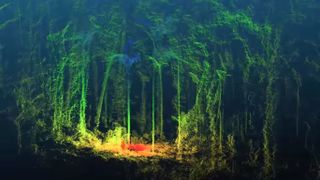NASA Flies Over Puerto Rico to Assess Forest Damage After Hurricanes
NASA is surveying the damage to Puerto Rico's forests after the devastation caused by Hurricanes Irma and Maria.
Category 5 Hurricane Maria hit Puerto Rico in September 2017 very shortly after Hurricane Irma, another Category 5 hurricane, hit the island. This caused severe damage and casualties from which the island's residents are still working to recover. A new flyover survey, described in a video from NASA's Goddard Space Flight Center in Maryland, shows how Puerto Rico's lush forests were impacted by the hurricane.
From the belly of a small plane, NASA flew an instrument called Goddard's Lidar, Hyperspectral and Thermal (G-LiHTs) airborne imager over Puerto Rico's forests. G-LiHT collected high-resolution photographs, surface temperatures and information about the height and structure of vegetation on the ground. The team had previously flown G-LiHT over Puerto Rico months before Hurricane Maria hit, so a pretty clear picture of the damage that the hurricane caused is obtained from comparing the two data sets.

"In many ways, Hurricane Maria has reset patches of forest across the island," Doug Morton, an Earth scientist at NASA's Goddard Space Flight Center, said in the video.
Morton added that "canopy trees normally have a large and sometimes circular crown, allowing them to spread their leaves, photosynthesize and live in the top of [the] canopy. Hurricane Maria came through and ripped off many of those large branches, leaving individuals standing almost like an individual stem."
Hurricane Maria had wind speeds topping out at 175 miles per hour and rains that pummeled towns and wreaked havoc on the island's power grid, so forest damage is no surprise. But, as Morton describes in the video, these trees will recover with time.
"They'll have to regrow those leaves or give up that space in the canopy to their neighbors as they regrow," Morton said. In the video, Morton shows how one tree knocked down its neighbors, which will allow sunlight to reach the forest floor and help new, young plant life to grow. He also points out that large trees, stripped of their large branches, will likely recover their leaves and branches with time.
Get the Space.com Newsletter
Breaking space news, the latest updates on rocket launches, skywatching events and more!
Email Chelsea Gohd at cgohd@space.com or follow her @chelsea_gohd. Follow us @Spacedotcom, Facebook and Google+. Original article on Space.com.
Join our Space Forums to keep talking space on the latest missions, night sky and more! And if you have a news tip, correction or comment, let us know at: community@space.com.

Chelsea “Foxanne” Gohd joined Space.com in 2018 and is now a Senior Writer, writing about everything from climate change to planetary science and human spaceflight in both articles and on-camera in videos. With a degree in Public Health and biological sciences, Chelsea has written and worked for institutions including the American Museum of Natural History, Scientific American, Discover Magazine Blog, Astronomy Magazine and Live Science. When not writing, editing or filming something space-y, Chelsea "Foxanne" Gohd is writing music and performing as Foxanne, even launching a song to space in 2021 with Inspiration4. You can follow her on Twitter @chelsea_gohd and @foxannemusic.
